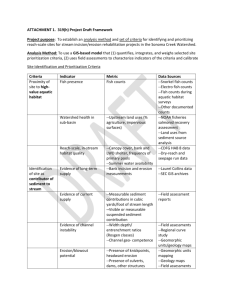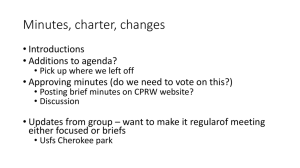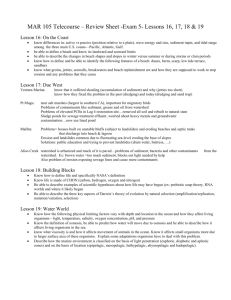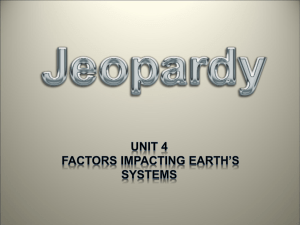P B R -
advertisement
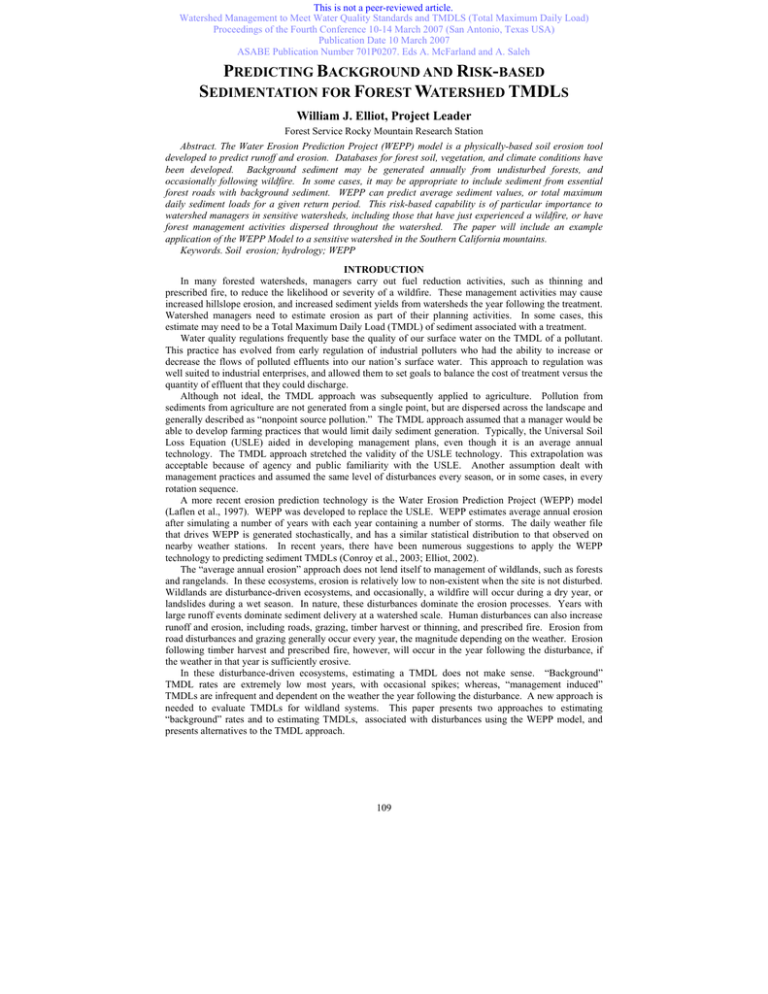
This is not a peer-reviewed article. Watershed Management to Meet Water Quality Standards and TMDLS (Total Maximum Daily Load) Proceedings of the Fourth Conference 10-14 March 2007 (San Antonio, Texas USA) Publication Date 10 March 2007 ASABE Publication Number 701P0207. Eds A. McFarland and A. Saleh PREDICTING BACKGROUND AND RISK-BASED SEDIMENTATION FOR FOREST WATERSHED TMDLS William J. Elliot, Project Leader Forest Service Rocky Mountain Research Station Abstract. The Water Erosion Prediction Project (WEPP) model is a physically-based soil erosion tool developed to predict runoff and erosion. Databases for forest soil, vegetation, and climate conditions have been developed. Background sediment may be generated annually from undisturbed forests, and occasionally following wildfire. In some cases, it may be appropriate to include sediment from essential forest roads with background sediment. WEPP can predict average sediment values, or total maximum daily sediment loads for a given return period. This risk-based capability is of particular importance to watershed managers in sensitive watersheds, including those that have just experienced a wildfire, or have forest management activities dispersed throughout the watershed. The paper will include an example application of the WEPP Model to a sensitive watershed in the Southern California mountains. Keywords. Soil erosion; hydrology; WEPP INTRODUCTION In many forested watersheds, managers carry out fuel reduction activities, such as thinning and prescribed fire, to reduce the likelihood or severity of a wildfire. These management activities may cause increased hillslope erosion, and increased sediment yields from watersheds the year following the treatment. Watershed managers need to estimate erosion as part of their planning activities. In some cases, this estimate may need to be a Total Maximum Daily Load (TMDL) of sediment associated with a treatment. Water quality regulations frequently base the quality of our surface water on the TMDL of a pollutant. This practice has evolved from early regulation of industrial polluters who had the ability to increase or decrease the flows of polluted effluents into our nation’s surface water. This approach to regulation was well suited to industrial enterprises, and allowed them to set goals to balance the cost of treatment versus the quantity of effluent that they could discharge. Although not ideal, the TMDL approach was subsequently applied to agriculture. Pollution from sediments from agriculture are not generated from a single point, but are dispersed across the landscape and generally described as “nonpoint source pollution.” The TMDL approach assumed that a manager would be able to develop farming practices that would limit daily sediment generation. Typically, the Universal Soil Loss Equation (USLE) aided in developing management plans, even though it is an average annual technology. The TMDL approach stretched the validity of the USLE technology. This extrapolation was acceptable because of agency and public familiarity with the USLE. Another assumption dealt with management practices and assumed the same level of disturbances every season, or in some cases, in every rotation sequence. A more recent erosion prediction technology is the Water Erosion Prediction Project (WEPP) model (Laflen et al., 1997). WEPP was developed to replace the USLE. WEPP estimates average annual erosion after simulating a number of years with each year containing a number of storms. The daily weather file that drives WEPP is generated stochastically, and has a similar statistical distribution to that observed on nearby weather stations. In recent years, there have been numerous suggestions to apply the WEPP technology to predicting sediment TMDLs (Conroy et al., 2003; Elliot, 2002). The “average annual erosion” approach does not lend itself to management of wildlands, such as forests and rangelands. In these ecosystems, erosion is relatively low to non-existent when the site is not disturbed. Wildlands are disturbance-driven ecosystems, and occasionally, a wildfire will occur during a dry year, or landslides during a wet season. In nature, these disturbances dominate the erosion processes. Years with large runoff events dominate sediment delivery at a watershed scale. Human disturbances can also increase runoff and erosion, including roads, grazing, timber harvest or thinning, and prescribed fire. Erosion from road disturbances and grazing generally occur every year, the magnitude depending on the weather. Erosion following timber harvest and prescribed fire, however, will occur in the year following the disturbance, if the weather in that year is sufficiently erosive. In these disturbance-driven ecosystems, estimating a TMDL does not make sense. “Background” TMDL rates are extremely low most years, with occasional spikes; whereas, “management induced” TMDLs are infrequent and dependent on the weather the year following the disturbance. A new approach is needed to evaluate TMDLs for wildland systems. This paper presents two approaches to estimating “background” rates and to estimating TMDLs, associated with disturbances using the WEPP model, and presents alternatives to the TMDL approach. 109 Table 1. Average annual predictions for a watershed and a hillslope in that are forested, burned, or thinned near Big Bear Lake, CA (Average annual precipitation is 1046 mm). Row Cover Channel Runoff (mm) Erosion (t ha-1) Critical Shear (Pa) Hillslope Watershed Hillslope Watershed 1 Forested 10 133 138 4.1 2.8 2 Wildfire 10 170 168 47.3 16.5 3 Forested 2 138 3.4 4 Thinned 10 113 116 7.0 5.3 5 Rx Fire 10 133 133 17.6 11.5 TYPICAL FOREST EROSION RATES Soil erosion rates are dependent on soil and plant properties, and surface residue, topography and slope. For a given disturbance condition, erosion rates are highly variable with the standard deviation sometimes approaching the mean on research studies (Elliot et al., 1989; Robichaud, 1996). Typically, the erosion from an undisturbed forest is seldom over one t ha-1 in dry forests, but could be greater than that in wetter forests. For example, watershed sediment delivery rates of 2 t ha-1 were observed at Caspar Creek in Northern CA, with an average annual precipitation of about 1000 mm (Rice et al., 1979). The erosion following thinning may double the erosion from an undisturbed forest, depending on the weather during the thinning operation year. A prescribed fire could increase the erosion rate above the undisturbed forest by a factor of 10, although it seldom does. Wildfire erosion rates can exceed 100 times the undisturbed forest erosion rate, depending on the weather. PREDICTED EROSION RATES Three WEPP technology interfaces that aid erosion prediction: online, Windows, and within a GIS (GeoWEPP). This paper will focus on outputs from the Windows version, and provides example output for one of the small watersheds draining into Big Bear Lake in San Bernardino County, California. The example watershed was delineated with GeoWEPP, but the WEPP runs for both the watersheds and the hillslopes were carried out in WEPP windows. All runs use the climate data from Lake Arrowhead, the nearest weather station recording an average annual precipitation of 1046 mm. This paper uses WEPP version 2006.5. This version incorporates lateral flow into the WEPP hydrology, so the runoff and erosion values will likely be higher than predicted by previous versions (Dun et al., 2006). The WEPP Windows Interface The most flexible WEPP interface is a standalone interface that runs in Windows. This interface can model either watersheds or hillslopes and has templates for the forest vegetation and soils. The interface generates average annual erosion and annual, seasonal, or single storm events. The interface also includes an estimation of single storm exceedance values for 24-h runoff, peak flow, and sediment delivery. Table 1 (Row 1) shows the average annual predictions for the example watershed and a single hillslope in that watershed for a 100-y run. Figure 1 shows the single storm return period analysis for the hillslope as shown in Table 1, and Figure 2 the single-storm return period values for the watershed. WEPP watershed also calculates the sediment delivery ratio for a watershed based on predicted erosion, deposition and sediment Figure 1. Return period analysis from WEPP Windows for a typical 7.4 ha forested hillslope in the Big Bear Lake Watershed, CA. 110 Figure 2. Return period analysis for a 68-ha forested watershed which includes the hillslope shown in Figures 1 and 2, Big Bear Lake Watershed, CA. delivery values on hillslopes and in channels. Table 1 shows the average annual erosion rates are 4.1 t ha-1 y-1 for the hillslope, and 2.8 t ha-1 y-1 for the watershed. WEPP predicted a sediment delivery ratio for this forested watershed of 0.55 for average annual erosion rates, suggesting that the example hillslope was contributing a disproportionate amount of sediment to the watershed. The example watershed’s area in Figure 2 is 68 ha, so the 10-yr return period sediment yield is 345 t or 5 t ha-1. This is smaller than the equivalent value for the hillslope of 7.4 t ha-1 (Figure 1) indicating soil deposition in the channel or disproportionately lower erosion on other hillslopes in the watershed for larger events. Comparing the peak runoff values between the hillslope and watershed modeled in Figures 1 and 2 requires converting units from m3 s-1 to mm h-1. The peak runoff rate predicted for the watershed’s 10-y event (Figure 2) is 147 mm h-1. This is larger than the value for the hillslope 116 mm h-1, and may be explained by greater runoff rates from other hillslopes, plus lateral flow contributions to the runoff. Another piece of information in Figure 2 is the sediment yield. If a sediment TMDL estimate is required, the modeler has to make a choice. As is clearly shown in Figure 2, the sediment TMDL is not a single value, but rather is a value associated with a probability. In any given year, there is a 50 percent probability of exceeding 196 t, the 2-y event value, and a 5 percent of exceeding 361 t, the 20-y event value. If a truly “maximum” daily load is required, then the manager may wish to put his/her computer through the paces and run the watershed for a longer period of simulated weather, say 500 years, to obtain a 250-y return period TMDL for sediment. This approach is pushing the capabilities of the WEPP weather generator. The climate files are based on statistics from climates with 40 to 100 years of weather. Such extrapolation is unwise, and return period values for greater than 50 years should be used with caution. A 500-y run for the watershed predicted 870 t of sediment for the 250-y return period. If the climate generated is reasonable, the probability of exceeding 870 t would happen once every 250 years, and so even this value can not be considered the TMDL. From this example, it is readily apparent that a TMDL in the absence of a probability of occurrence cannot truly be set for nonpoint source pollution analysis. For the remainder of this paper, the TMDL values associated with 10-y events will be compared. Thus, the forested hillslope predictions in Figure 1 would have a 10-yr sediment TMDL of 7.4 t ha-1 or 55 t, and the watershed in Figure 2 would have a 10-y sediment TMDL of 5 t ha-1 or 345 t. BACKGROUND EROSION RATES One of the challenges when carrying out a watershed analysis is determining a “background” or “natural” erosion rate. Figures 1 and 2 are from a small forested watershed and a hillslope within that watershed. The predicted average annual erosion rate on the hillslope is 4.1 t ha-1 (Table 1) and for the forested watershed, is 2.8 t ha-1. Forest watershed managers often assume that these average values are reasonable for forested conditions, and define them as “background”. Any erosion rates caused by management practices are compared to these “background” values. Frequently, forest managers then consider a 10 or 20 percent variance above the “background” erosion rate due to management activities as acceptable. Such an analysis, however, does not reflect the nature of a disturbance-driven ecosystem. Undisturbed forests will experience wildfires. The frequency of such wildfires depends on the climate: a forest with 500 to 600 mm of annual precipitation will likely experience a wildfire once every 50 years, whereas a forest with an annual precipitation of 1000 mm will likely experience a wildfire once every 100 to 200 years (McDonald et al., 2000). Coastal range forests with precipitation over 1500 mm generally have a fire return interval of 300 years or more. For the example in this paper, the fire return interval will likely be around 150 years. When such a fire occurs, the resulting erosion rates may be extremely high. 111 Figure 3. Return period analysis for a 68-ha watershed following a wildfire, Big Bear Lake Watershed, CA. The the input files for a wildfire were specified for the example watershed, and the predicted average annual runoff and sediment yield are presented in Table 1, Row 2. Figure 3 presents the return period analysis for a wildfire. The “average” sediment delivery rate following wildfire is 16.5 t ha-1 with an average delivery ratio of 0.282. This means that the “average” hillslope erosion rate is 58.5 t ha-1 (16.5÷0.282), and of that, on the average, the equivalent of 42 t ha-1 (58.5-16.5) or 2856 t is deposited in the stream channel. There are several ways to incorporate this information into a “background” estimation. One method proposed by Elliot (2006) is to average the gross hillslope erosion (42 t ha-1) over the fire return interval. In this example, with a 150-year fire return interval, that would mean adding an additional 0.28 t ha-1 y-1 to the undisturbed forest erosion rate, leading to a “background” value of 3.1 t ha-1 y-1. Such an approach would suggest that any disturbance that resulted in an “average” increase of less than this amount would be within the “background” erosion rate. Another approach to estimating the effect of the wildfire on “background” erosion is to assume that the excessive 2856 t of sediment deposited in the channel, and will be routed through the stream system during large runoff events that may occur before the next wildfire in 150 years time. In order to model this condition, the “Gravel Channel” template in the watershed is replaced with an “Earth Channel.” The main difference between these two channels is the critical shear value of the channel. The gravel channel has a critical shear specified as 10 Pa, whereas the earth channel has a critical shear value of 2 Pa. Row 3 of Table 1 shows the simulated value for average annual conditions for background erosion of the Earth channel is 3.4 t ha-1. This is an increase of about 21 percent greater than the erosion from a forested gravel channel, as is similar to the value of 3.1 t ha-1 obtained in the previous paragraph. As sediments in the channel are carried downstream during wet years, the sediment yield from the watershed will eventually decline to 2.8 t ha-1 in the absence of another wildfire. Figure 4 shows the return period analysis for this watershed with an earth channel. When comparing Figure 4 with Figure 2, there is little difference in single storm delivery for different channel beds. Sediment delivery from forested watersheds for large events appears to be more a function of sediment yield from eroding hills than of channel scouring during large runoff events in this example watershed. EROSION FROM FOREST ACTIVITIES Human induced forest disturbances include thinning, prescribed fire, and the road network (Elliot 2006). This paper will focus on the first two, although sediment from the road network may well exceed sediment from the hillslope disturbances in some watersheds. Experience has shown that the main erosion-causing Figure 4. Return period analysis of the 68-ha forested watershed if the channel is earth rather than gravel as shown in Figure 2, Big Bear Lake Watershed, CA 112 effect of thinning is to reduce the ground cover on the site. With care, this can be limited to less than 15 percent mineral soil exposure. For example, Elliot and Miller (2004) measured a ground cover of 70 percent on skid trails, which accounted for less than 10 percent of the watershed area, resulting in total remaining cover of about 93 percent. Generally, the hydraulic conductivity decreases, and the erodibility increases on slopes that are thinned. Elliot et al. (2000) have suggested input values that were applied to the example watershed. The average annual results for thinning are in Row 4 of Table 1. At the watershed scale, sediment delivery has increased from 2.8 t ha-1 y-1 for an undisturbed forest to 5.3 t ha-1 y-1. It is also interesting to note that even though the sediment delivery increased, the surface runoff decreased from 138 mm for a forested watershed to 116 mm. This is because the loss of forest canopy results in an earlier, lower intensity snow melt rate, so more of the snowpack infiltrates early in the spring with the more open canopy following thinning. If considering the probability values, Figure 5 shows that the 10-yr sediment delivery increases from 344 t to 672 t, almost doubling. The value associated with thinning is still only half thatFigure associated with wildfire. From this is apparentassuming that thinning a similarwas impact on extreme 5. Return Period Analysis for analysis, the 68-haitwatershed entirehas watershed thinned, Big events as it does on an overall average sediment delivery. Bear Lake Watershed, CA PRESCRIBED FIRE To complete the fuel management analysis, the example watershed was run for a prescribed fire. This run assumed about 85 percent cover with a “low severity” soil that is not water repellent (Elliot et al., 2000). Table 1, Row 5 shows the results for the average annual values with the return period analysis in Figure 6. The prescribed fire generates about a third of the wildfire sediment at the hillslope scale, but about two thirds at the watershed scale. The average annual sediment delivery ratio for the wildfire is 0.28, compared to a delivery ratio of 0.41 for the prescribed fire. When comparing the 10-yr return period sediment load, there is a 10 percent chance that sediment delivery will exceed 1251 t for this watershed following prescribed fire. DISCUSSION TMDLs This suite of runs is typical of those recommended for a fuel management analysis (Elliot, 2006; Elliot and Robichaud, 2006). Average annual results from a single hillslope, and from a typical watershed, are presented in Table 1. Table 2 summarizes TMDLs associated with a 10-yr return period. If the focus is TMDLs, then the maximum natural TMDL is that associated with a severe wildfire. In neither the thinning nor the prescribed fire did the TMDL associated with the 10-year return period exceed the wildfire value (Table 2). This table shows that if wildfire is considered, then the TMDLs from the fuel treatment activities are always less than from a wildfire. To ignore the wildfire in managing forest watersheds is inappropriate, as wildfire is a natural part of any forest ecosystem. There will still be wildfire following management activities, but current research is showing that it will likely be less severe, and in some cases, may stop the spread of a wildfire because of insufficient fuel availability. Table 2 also shows that as hillslope erosion rates go up, sediment delivery ratios go down, leaving more sediment deposited in the channels. If the channel is filled with deposited sediment, then sediment will continue to be delivered in the years following a disturbance not only from the hillslopes, but also from increased channel erosion. Table 2 shows that the 10-y return period sediment yield from a forest with a more erodible channel is similar to an undisturbed forest, even though Table 1 showed an overall average annual increase in delivered sediment of 21 percent when changing the channel from gravel to earth. Figure 6. Return Period Analysis for a 68-ha watershed following a prescribed fire assuming the entire watershed was burned, Big Bear Lake Watershed, CA. 113 Table Impact base on Average Annualratios, Erosion the example Table 3. 2. Fuel PeakManagement runoff rates for 10-y Analysis return period, sediment delivery andRates total for maximum daily Bigexample Bear Lake, CA ed, near Big Bear Lake, CA sediment loads for 10-y retuhillslope rn periodnear for the watersh Frequency Average annual Condition Sedim ent of Sediment TMDL Condition Sediment PeakDelivery Runoff the 3 -1 occurrence sediment delivery yearRate of occurrence s ) Deli very Ratio (t) (m yr-1) (t ha-1 yr-1) (t ha2-17.9 Forested 0.55(y) 345 Forested 4.1 1 Wildfire 27.9 0.28 1307 4.1 Wildfire 47.3 150 Thinned 27.1 0.52 672 0.3 “Background” Rx Fire 28.0 0.41 1251 4.4 (Forest + fire) Forest with earth 27.9 0.65 339 Forested 4.1 1 4.1 channel Thinned 7.0 20 0.35 Rx Fire 17.6 20 0.9 Managed 5.35 (Forest+Thin+Rx) Runoff Table 2 shows that there does not appear to be any difference in peak runoff rates due to fuel management, whereas Table 1 records differences in average annual runoff. This is likely due to the fact that peak runoff rates tend to occur when the forest is saturated. In these conditions, the infiltration rates will be minimal, and so the difference in runoff is more a function of the storm or snowmelt characteristics than of soil properties. Once a soil is saturated, there is little impact from management on peak runoff rates. This prediction requires further analysis because current thinking is that peak runoff rates increase by a factor of 10 to 100 following wildfire. Average Annual Sediment Delivery The alternative approach suggested by Elliot (2006) and Elliot and Robichaud (2006) for evaluating the watershed effects of fuel management is to consider average annual values for individual hillslopes rather than TMDLs. These authors suggest that because the nature of the climate in the year following a disturbance is unknown, the best approach is to consider a number of different years and then use the average for those years. For the examples in this paper, the model generated 100 different years of weather to determine an average value. To obtain a background erosion rate, add the average annual sediment delivery from the wildfire divided by the fire return interval to the sediment delivery from each forested hillslope. Compare this value to the sediment delivery from each of the fuel treatments divided by their frequency of occurrence. The manager can then compare the natural values, including wildfire, to the managed values with or without wildfire (Table 3). In this example climate, where erosion rates are high and wildfire is rare because of the high precipitation, there is a 22 percent increase in “average annual sediment” delivered from the hillslope due to fuel treatment. for a complete analysis, do the same for other hillslopes in the watershed. An online interface was developed to aid in making multiple runs and preparing output tables similar to Table 3 to aid in planning for fuel management (Elliot and Robichaud, 2006). In drier climates, the sediment increase is even less, and in many cases, the increase due to fuel treatment is less than the erosion from wildfire, justifying fuel management treatment for sediment reduction benefits alone. Sediment reduction is not the only reason for fuel management. In this example, fuel management within a wildland-urban interface will likely be desirable to protect the considerable number of homes built in this area, in spite of increased sediment delivery to Big Bear Lake. CONCLUSION For any analysis of nonpoint source pollution associated with soil erosion, developing a Total Maximum Daily Load is problematic. This is particularly true for such disturbance-driven ecosystems as forests. The TMDL associated with a forest will likely be the load that will follow a wildfire. To decrease this number, thinning and prescribed fire may be used to reduce the risk of a severe wildfire occurring. The wildfire TMDL value can be estimated, and if current management practices are followed, the management TMDL values are unlikely to exceed those generated by wildfire. The TMDL value should be linked to a probability of occurring. An alternative approach for forests is suggested. This approach considers average annual values for sediment from individual hillslopes. The forest managers can average background sediment over the fire return interval and fuel treatment-generated sediment over the period between fuel treatments. Background values can be estimating for TMDLs for an undisturbed forest by assuming the channel is in a highly erodible condition, as would be the case following a wildfire. If using average annual values, then the background value is the erosion rate of an undisturbed forest plus the erosion rate following a wildfire 114 divided by the fire return interval. REFERENCES Conroy, W. J., J. Wu and W. J. Elliot. 2003. Proposed modifications to the WEPP model to improve sediment yield predictions for TMDL scenario analysis. Presented at the 2003 ASAE Annual International Meeting, Paper No. 032055. St Joseph, MI: ASAE. 13 p. Dun, S., J. Q. Wu, W. J. Elliot, P. R. Robichaud, and D. C. Flanagan. 2006. Adapting the Water Erosion Prediction Project (WEPP) Model to forest conditions. Presented at that Annual International Meeting of the ASABE. Paper No. 062150. 9-12 July, Portland, OR. St. Joseph, MI: ASABE. 16 p. Elliot, W.J. 2002. Predicting sediment TMDLs for forest conditions with the WEPP model. In: Saleh, A., ed., Total Maximum Daily Load (TMDL) Environmental Regulations: Proceedings of the March 11-13 ASAE Conference, Fort Worth, TX. ASAE Publication Number 701P0102. p. 554-559. Elliot, W. J. 2006. The roles of natural and human disturbances in forest soil erosion. Chapter 17. In Owens, P. N. and A. J. Collins (eds.). Soil Erosion and Sediment Redistribution in River Catchments. Wallingford OX, UK: CAB International. 177-185. Elliot, W. J., A. M. Liebenow, J. M. Laflen and K. D. Kohl. 1989. A compendium of soil erodibility data from WEPP cropland soil field erodibility experiments 1987 & 88. Report No. 3. USDA-ARS, National Soil Erosion Research Laboratory, W. Lafayette, IN. 316 p. Elliot, W. J. and I. S. Miller. 2004. Measuring Low Rates of Erosion from Forest Fuel Reduction Operations. An ASAE/CSAE Meeting Presentation. Presented at the Annual International Meeting of the ASAE and CSAE. Paper Number: 045018. 1-4 August, Ottawa, Canada. St. Joseph, MI: ASAE. 10 p. Elliot, W. J., D. E. Hall and D. L. Scheele. 2000. Disturbed WEPP (Draft 02/2000) WEPP Interface for Disturbed Forest and Range Runoff, Erosion and Sediment Delivery. Online documentation at http://forest.moscowfsl.wsu.edu/fswepp/docs/distweppdoc.html. Accessed Dec. 2006. Elliot, W. J. and P. R. Robichaud. 2006. WEPP FuME Fuel Management Erosion Analysis. Online at http://forest.moscowfsl.wsu.edu/cgi-bin/fswepp/fume/fume.pl . Accessed Dec. 2006. Laflen, J. M., W. J. Elliot, D. C Flanagan, C. R Meyer, and M. A. Nearing. 1997. WEPP–Predicting water erosion using a process-based model. Journal of Soil and Water Conservation 52(2): 96-102. McDonald, G. I., A. E. Harvey and J. R. Tonn. 2000. Fire, competition and forest pests: Landscape treatment to sustain ecosystem function. IN Neuenschwander, L. F., and K. C. Ryan (eds.). Proceedings from the Joint Fire Science Conference and Workshop, Boise, ID. June 15-17, 1999. Online at < http://jfsp.nifc.gov/conferenceproc/T-11McDonaldetal.pdf > . Accessed June, 2004. 17 p Rice, R. M., F. B. Tilley and P. A. Datzman. 1979. A watershed’s response to logging and roads: South Fork of Caspar Creek, California, 1967-1976. Research Paper PSW-146. Berkeley, CA: Forest Service Pacific Southwest Forest and Range Experiment Station. 12 p. Robichaud, P. R. 1996. Spatially-varied erosion potential from harvested hillslopes after prescribed fire in the interior northwest. Ph. D. dissertation. Moscow, ID:University of Idaho. 219 pp. 115
